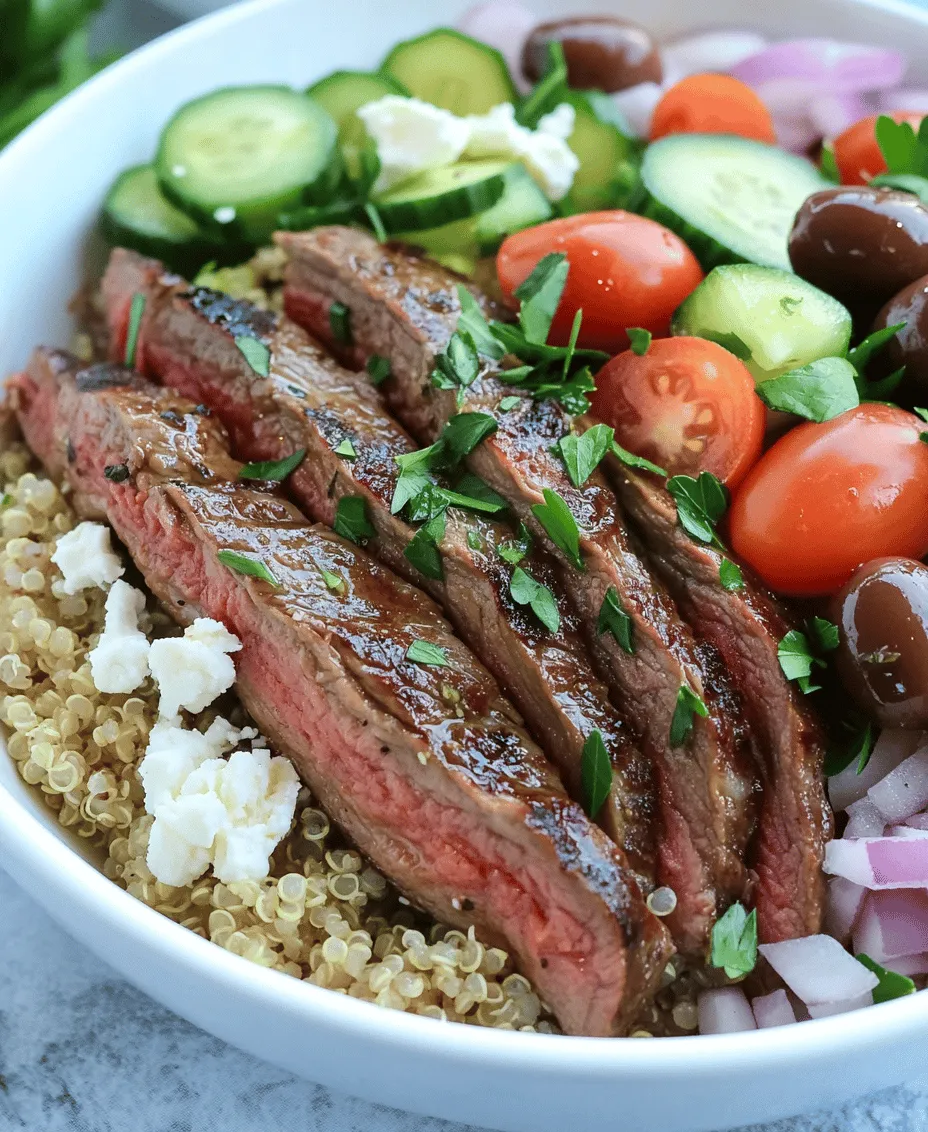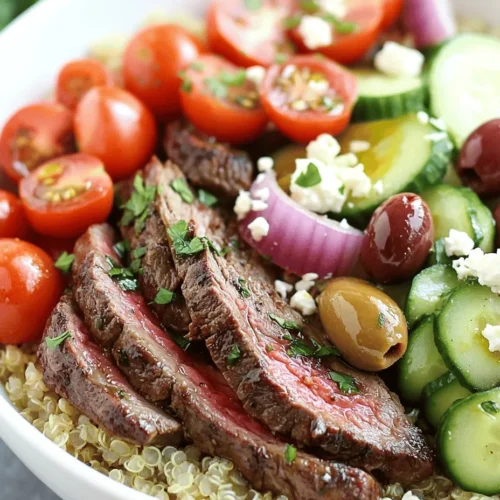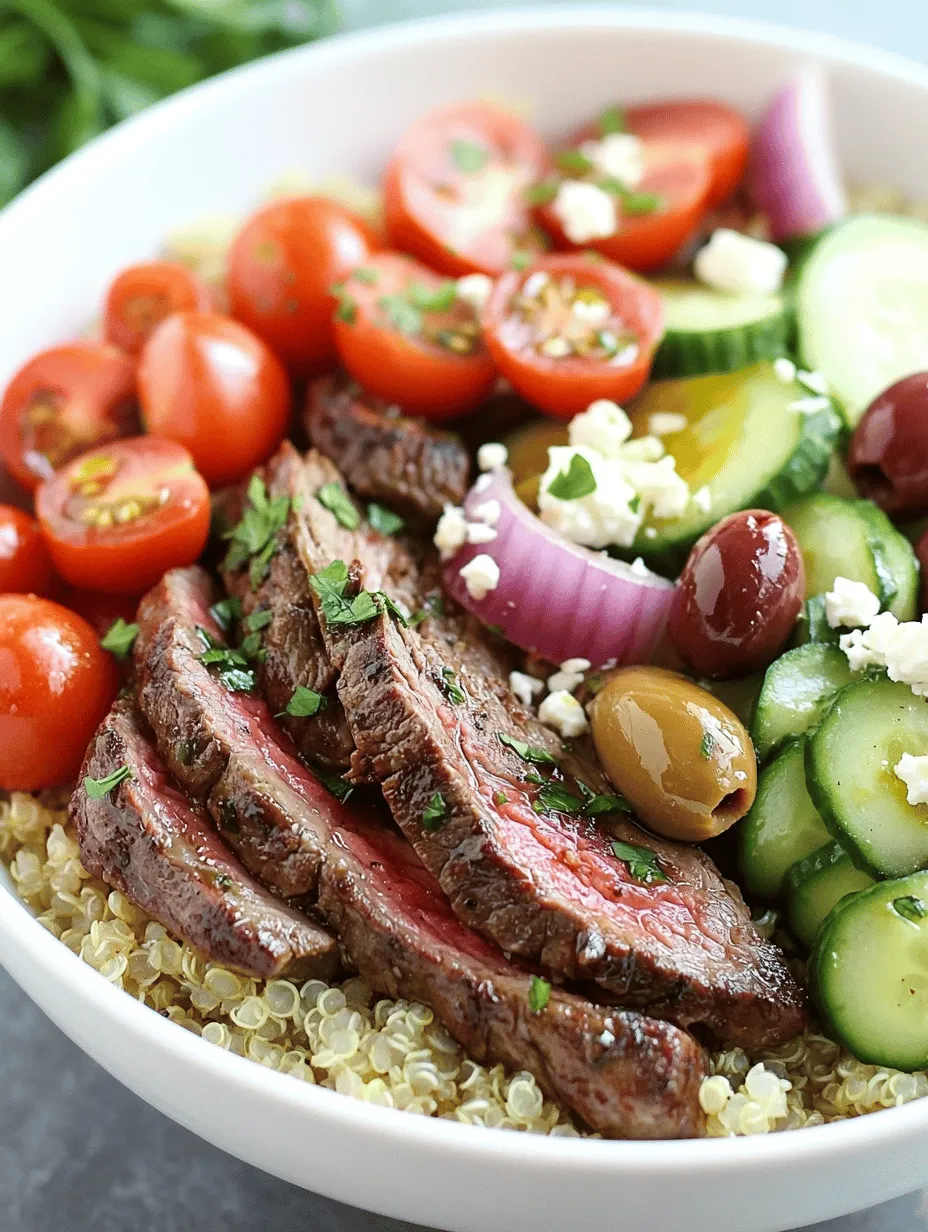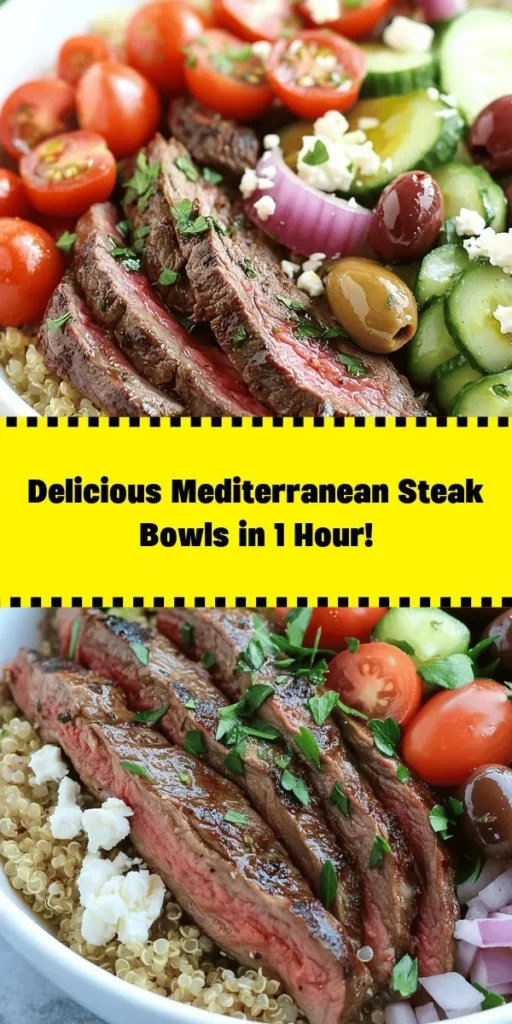Introduction
Mediterranean cuisine is celebrated not only for its vibrant flavors but also for its numerous health benefits. Rooted in the culinary traditions of countries surrounding the Mediterranean Sea, this cuisine emphasizes the use of fresh vegetables, whole grains, lean proteins, and healthy fats. The Mediterranean diet is renowned for promoting heart health, reducing the risk of chronic diseases, and supporting overall well-being. As more people become health-conscious, they are drawn to meals that are both nutritious and satisfying.
One such dish that encapsulates the essence of Mediterranean cooking is the Mediterranean steak bowl. This delightful meal combines marinated flank steak with a variety of colorful ingredients, all served in a single bowl, making it an ideal option for anyone seeking a balanced meal. The growing popularity of bowl meals in contemporary diets speaks to their convenience and versatility, allowing for easy customization to suit individual dietary preferences.
The Mediterranean steak bowl is more than just a meal; it’s an experience. The use of fresh, wholesome ingredients is crucial in creating the vibrant flavors characteristic of Mediterranean cuisine. From the rich taste of grilled steak to the refreshing crunch of fresh vegetables, each element works harmoniously to deliver a satisfying and nutrient-rich dish.
Understanding the Ingredients
A successful Mediterranean steak bowl hinges on carefully selected ingredients that complement each other in flavor and nutrition. Here, we will explore the key components that make this dish a standout choice for health-conscious eaters.
Flank Steak
At the heart of the Mediterranean steak bowl is flank steak, a cut of beef known for its rich flavor and relatively lean profile. Flank steak is not only delicious but also packed with nutrients. It’s a great source of protein, iron, and B vitamins, which are essential for energy production and muscle maintenance. When cooked properly, flank steak is tender and juicy, making it a perfect centerpiece for any bowl meal.
Olive Oil
Olive oil is a staple in Mediterranean cooking, known for its numerous health benefits. Rich in monounsaturated fats, olive oil can help reduce inflammation and lower the risk of heart disease. Additionally, it enhances the flavor of the steak and other ingredients in the bowl. When preparing the marinade for the flank steak, using high-quality extra virgin olive oil can elevate the dish’s overall taste profile while contributing to its health benefits.
Quinoa
As a nutritious grain alternative, quinoa has gained popularity among health enthusiasts for its impressive nutritional profile. Packed with protein and fiber, quinoa is a complete protein source, meaning it contains all nine essential amino acids. This makes it an excellent option for those seeking plant-based protein. Quinoa is also gluten-free and rich in vitamins and minerals, including magnesium, phosphorus, and iron. In the Mediterranean steak bowl, quinoa serves as a hearty base that complements the other ingredients while providing a satisfying texture.
Fresh Vegetables
The importance of variety and color in meals cannot be overstated, and fresh vegetables play a pivotal role in the Mediterranean steak bowl. Utilizing a mix of vibrant vegetables, such as bell peppers, cucumbers, cherry tomatoes, and red onions, adds not just visual appeal but also an array of vitamins and antioxidants. These vegetables contribute to the overall nutritional value of the dish, providing fiber, vitamins A and C, and other essential nutrients. The combination of different textures and flavors from the vegetables enhances the eating experience, making each bite a celebration of freshness.
Feta Cheese
No Mediterranean dish is complete without feta cheese, which adds a creamy and tangy element to the steak bowl. Feta is a type of brined cheese made from sheep’s milk or a mixture of sheep and goat’s milk. It is lower in calories and fat compared to many other cheeses, making it a healthier option for adding richness to dishes. In addition to its delightful taste, feta cheese is also a source of calcium and protein, contributing to the overall health benefits of the meal. Its crumbly texture pairs beautifully with the other ingredients, lending a satisfying creaminess to each bite.
Herbs and Spices
A hallmark of Mediterranean cooking is the abundant use of herbs and spices, which infuse dishes with aromatic flavors and health benefits. In the Mediterranean steak bowl, garlic powder, smoked paprika, and oregano are three key ingredients that elevate the dish.
– Garlic Powder: Known for its distinct flavor and numerous health properties, garlic is touted for its ability to boost the immune system and reduce blood pressure. Using garlic powder in the marinade adds depth to the steak’s flavor profile.
– Smoked Paprika: This spice brings a hint of smokiness and sweetness to the dish. Rich in antioxidants, smoked paprika can also help reduce inflammation and improve overall health.
– Oregano: A classic herb in Mediterranean cuisine, oregano adds a robust flavor and aroma. It is also known for its antibacterial properties and is rich in antioxidants, making it a valuable addition to any meal.
Together, these herbs and spices enhance not only the flavor of the steak but also contribute to the overall healthfulness of the Mediterranean steak bowl.
Preparation Steps Explained
Creating a Mediterranean steak bowl is a straightforward process that involves several key steps. Each step is crucial for ensuring that the flavors meld beautifully and that the dish is as nutritious as it is delicious.
Marinating the Steak
One of the most important steps in preparing a Mediterranean steak bowl is marinating the flank steak. Marinating allows the meat to absorb flavors, resulting in a more tender and flavorful dish. The marinade typically consists of olive oil, garlic powder, smoked paprika, oregano, salt, and pepper.
Importance of Marinating for Flavor and Tenderness
Marinating not only enhances the flavor but also helps to tenderize the meat. Flank steak, while flavorful, can be tough if not cooked properly. The acids in the marinade, such as those from vinegar or citrus juice (if added), can break down the proteins in the meat, resulting in a more tender texture.
Suggested Marinating Times and Techniques for Best Results
For the best results, allow the flank steak to marinate for at least 30 minutes, although longer marinating times (up to 24 hours) can yield even better flavor. To marinate, simply combine the marinade ingredients in a resealable plastic bag or shallow dish, add the steak, and ensure it is well-coated. Seal the bag or cover the dish, and refrigerate until ready to cook.
Cooking the Quinoa
While the steak is marinating, it’s time to prepare the quinoa. Cooking quinoa is simple, but there are a few tips to ensure it turns out perfectly fluffy.
Step-by-Step Guide to Cooking Quinoa Perfectly
1. Rinse the Quinoa: Quinoa has a natural coating called saponin, which can impart a bitter taste if not rinsed off. Place the quinoa in a fine mesh strainer and rinse under cold running water for a few minutes.
2. Cook the Quinoa: In a saucepan, combine the rinsed quinoa with water or vegetable broth. The ratio is typically 1 part quinoa to 2 parts liquid. For added flavor, consider using vegetable broth instead of water.
3. Bring to a Boil: Bring the liquid to a boil over medium-high heat, then reduce the heat to low and cover the saucepan with a lid.
4. Simmer: Let the quinoa simmer for about 15 minutes or until all the liquid is absorbed. Avoid lifting the lid during cooking, as this can disrupt the steaming process.
5. Fluff and Serve: Once cooked, remove the saucepan from heat and let it sit covered for 5 minutes. Then, fluff the quinoa with a fork before serving.
Benefits of Using Vegetable Broth Versus Water
Using vegetable broth instead of water not only enhances the flavor of the quinoa but also adds an extra layer of nutrition. Broth contains vitamins and minerals that can further enrich the dish, making it a more wholesome option.
Grilling the Steak
Once the quinoa is cooked and the steak has marinated, it’s time to grill the steak to perfection. Grilling gives the flank steak a delicious char and enhances its flavor.
Grilling Techniques for Best Results
1. Preheat the Grill: Ensure your grill is preheated to medium-high heat (about 400-450°F) before placing the steak on it. A properly heated grill is essential for achieving those beautiful grill marks and a nice sear.
2. Grill the Steak: Remove the steak from the marinade, allowing any excess liquid to drip off. Place it on the grill and cook for about 4-6 minutes per side for medium-rare, or longer if you prefer it more done. Use tongs to flip the steak, avoiding piercing it with a fork to retain the juices.
3. Rest the Steak: Once cooked to your desired doneness, remove the steak from the grill and let it rest for at least 5 minutes. Resting is crucial as it allows the juices to redistribute throughout the meat, ensuring a tender and juicy steak.
By following these steps, you will be well on your way to creating a Mediterranean steak bowl that is not only delicious but also packed with nutrients. The combination of marinated steak, fluffy quinoa, fresh vegetables, and creamy feta cheese creates a truly satisfying meal that can be enjoyed any day of the week.

Tips for Grilling to Achieve Desired Doneness
Grilling steak to perfection requires attention to detail and an understanding of how to gauge doneness. For the best results, use a reliable meat thermometer. Here are some key temperature targets for various levels of doneness:
– Rare: 120-130°F (49-54°C)
– Medium Rare: 130-135°F (54-57°C)
– Medium: 135-145°F (57-63°C)
– Medium Well: 145-155°F (63-68°C)
– Well Done: 155°F (68°C) and above
To achieve your desired doneness, preheat your grill on high for about 15-20 minutes. Sear the steak on both sides for about 2-3 minutes, creating a beautiful crust. After searing, reduce the heat to medium and cook to your preferred temperature. Always remember to turn the steak once to avoid drying it out, and avoid pressing down on it with a spatula, which can release juices and lead to a less tender result.
Importance of Resting Meat Before Slicing for Optimal Tenderness
Once your steak has reached the desired doneness, it’s crucial to let it rest for at least 5-10 minutes before slicing. Resting allows the juices to redistribute throughout the meat, ensuring each bite is juicy and flavorful. If you slice into the steak immediately, the juices will run out, resulting in a dry texture. Tent the steak loosely with foil during this resting period to keep it warm while you prepare the remaining components of your Mediterranean steak bowl.
Preparing the Bowl Components
How to Create a Colorful and Appetizing Vegetable Mix
The vegetables in your Mediterranean steak bowl not only add nutrition but also enhance the dish’s visual appeal. To achieve a vibrant mix, consider using a variety of colors and textures. Here’s how to prepare your vegetable mix:
1. Choose Your Vegetables: Opt for a mix of bell peppers, cherry tomatoes, cucumbers, red onions, and zucchini. These ingredients are not only colorful but also provide a range of flavors and nutrients.
2. Chop and Toss: Dice the bell peppers and cucumbers into bite-sized pieces, halve the cherry tomatoes, and slice the red onions thinly. For zucchini, you can either spiralize it for a fun texture or slice it into coins.
3. Seasoning: In a large bowl, combine the vegetables and drizzle with olive oil, salt, pepper, and a squeeze of fresh lemon juice. Toss gently to coat everything evenly. The lemon juice not only brightens the flavors but also adds a nutritional boost, as it’s rich in vitamin C.
Importance of Fresh Lemon Juice for Flavor and Nutrition
Fresh lemon juice plays a pivotal role in enhancing the flavors of your Mediterranean steak bowl. Its zesty acidity cuts through the richness of the steak and balances the sweetness of the vegetables. Additionally, lemon juice is packed with antioxidants and vitamin C, which are beneficial for immune health and skin vitality.
Using fresh lemon juice instead of bottled varieties elevates the dish, providing a fresher taste and an aromatic fragrance that complements the grilled steak beautifully.
Assembling the Mediterranean Steak Bowls
Detailed Instructions on Assembling the Bowl for Visual Appeal and Flavor Balance
Assembling your Mediterranean steak bowl is where the magic happens. Follow these steps to create a visually appealing and flavorful dish:
1. Base Layer: Start with a base of cooked grains such as quinoa, couscous, or brown rice. These grains provide a hearty foundation for your bowl and contribute to its nutritional value.
2. Add Vegetables: Next, layer your colorful vegetable mix on top of the grains. Arrange them in sections to create a rainbow effect, which makes the bowl visually stunning.
3. Sliced Steak: After allowing the steak to rest, slice it against the grain into thin strips and place it on top of the vegetables. This not only enhances tenderness but also adds an elegant touch to your bowl.
4. Drizzle Dressing: For added flavor, drizzle a homemade tahini sauce or a yogurt-based dressing over the top. You can make a simple dressing by mixing Greek yogurt, minced garlic, fresh herbs, and a splash of lemon juice.
5. Garnish: Finally, sprinkle some crumbled feta cheese, chopped parsley, and a few olives for an authentic Mediterranean touch.
Tips for Portion Control and Customization Based on Dietary Preferences
Creating a Mediterranean steak bowl allows for easy customization based on dietary needs. Here are some tips to ensure everyone enjoys their meal:
– Portion Control: Use measuring cups for grains and vegetables to ensure balanced portions. A serving of grains should be about one cup, with half a cup of vegetables and a serving of protein around 3-4 ounces.
– Dietary Preferences: For gluten-free options, substitute grains with cauliflower rice or a bed of leafy greens. Vegetarians can replace steak with grilled marinated tofu or chickpeas, ensuring they still enjoy the rich flavors of the Mediterranean.
– Flavor Variations: Experiment with different dressings, adding harissa for spice or tahini for creaminess. You can also swap out vegetables based on seasonal availability or personal preference, such as roasted eggplant or artichoke hearts.
Suggestions for Additional Toppings or Variations to Suit Different Tastes
To elevate your Mediterranean steak bowl further, consider these additional toppings and variations:
– Herbs: Fresh herbs like dill, mint, or basil can add depth and freshness to your bowl.
– Nuts and Seeds: Sprinkle some toasted pine nuts or sunflower seeds for crunch and healthy fats.
– Grains: Swap out quinoa for farro or barley for varied textures.
– Spices: Add a dash of smoked paprika or sumac for a unique flavor twist.
– Chopped Avocado: For creaminess and healthy fats, add sliced or diced avocado to your bowl.
Nutritional Value of the Mediterranean Steak Bowl
Breakdown of Calories, Macronutrients, and Vitamins per Serving
A Mediterranean steak bowl is not just a feast for the eyes; it’s also a nutritious meal option. Here’s a general breakdown of what one serving (including quinoa, grilled steak, and vegetables) might contain:
– Calories: Approximately 600 calories
– Protein: 40g
– Carbohydrates: 50g
– Fat: 25g
– Fiber: 10g
This meal is rich in macronutrients, providing a balanced combination of proteins, carbs, and healthy fats, making it an excellent choice for a satisfying lunch or dinner.
Health Benefits Associated with the Ingredients Used
Each ingredient in your Mediterranean steak bowl carries its own set of health benefits:
– Lean Steak: A great source of protein, iron, and B vitamins, contributing to muscle health and energy levels.
– Quinoa: A complete protein containing all nine essential amino acids, high in fiber, and gluten-free.
– Vegetables: Packed with vitamins (A, C, K), minerals, and antioxidants that support overall health and reduce inflammation.
– Olive Oil: Rich in monounsaturated fats, olive oil is known for its heart health benefits and anti-inflammatory properties.
Heart Health, Weight Management, and Anti-Inflammatory Properties
The Mediterranean diet is often praised for its heart-healthy benefits. This bowl embodies those principles, promoting cardiovascular health through lean proteins, healthy fats, and plenty of fresh vegetables. The fiber content aids in digestion and can support weight management, while the anti-inflammatory properties of the ingredients may help reduce chronic disease risks.
Discussion on How This Meal Fits into a Balanced Diet
Incorporating a Mediterranean steak bowl into your weekly meal planning can be a delicious way to ensure you’re consuming a variety of nutrients. This meal can easily fit into a balanced diet when paired with other healthy foods throughout the day, such as fruits, whole grains, and low-fat dairy. Its versatility allows you to tailor it to your nutritional needs, whether you’re looking to increase protein intake or reduce carbohydrates.
Cultural Significance of Mediterranean Cuisine
Exploration of Mediterranean Culinary Traditions and Their Influence on Global Food Trends
Mediterranean cuisine is renowned for its health benefits and flavorful ingredients, drawing from a rich tapestry of traditions across countries like Greece, Italy, Spain, and Turkey. The emphasis on fresh produce, lean proteins, whole grains, and healthy fats has influenced global food trends, promoting a shift towards more plant-based diets and mindful eating.
Importance of Sharing Meals and the Communal Aspect of Mediterranean Eating
At the heart of Mediterranean cuisine is the joy of sharing meals with family and friends. The communal aspect of dining encourages people to gather, enjoy good food, and foster connections. This recipe reflects that essence, inviting you to prepare and share a colorful, nutritious meal with loved ones.
How This Recipe Reflects the Essence of Mediterranean Culture
The Mediterranean steak bowl encapsulates the spirit of Mediterranean culture by celebrating fresh ingredients, vibrant flavors, and the joy of communal dining. It encourages creativity in the kitchen and promotes a lifestyle that values quality over quantity, making each meal an experience to savor.
Conclusion
In summary, the Mediterranean steak bowl emerges as a delicious, nutritious, and visually appealing meal that brings together the best of Mediterranean flavors. With its colorful mix of grilled steak, fresh vegetables, and wholesome grains, it stands out as a perfect option for those looking to explore the vibrant tastes of the Mediterranean.
We encourage you to experiment with this recipe, incorporating your favorite ingredients and variations to create your own personalized bowl. Embrace the joy of cooking with fresh ingredients, and share this delightful meal with family and friends, nourishing both body and soul. Enjoy the culinary journey that awaits you in every bite!



